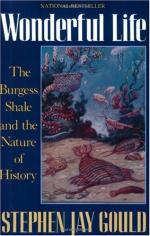
|
| Name: _________________________ | Period: ___________________ |
This quiz consists of 5 multiple choice and 5 short answer questions through The Burgess Drama, Act 2. A New View Takes Hold: Homage to Opabinia, 1975.
Multiple Choice Questions
1. How does Walcott group the Burgess arthropods among the arthropod phylum?
(a) Widely.
(b) Minutely.
(c) Hardly.
(d) Narrowly.
2. What did Walcott think Opabinia was just another one of?
(a) Mollusk.
(b) Plant.
(c) Crustacean.
(d) Anemone.
3. What does the Precambrian Era contain?
(a) Spatial, non-biological time and the decimation of single-celled life.
(b) Geological, non-biological time and the advent of single-celled life.
(c) Physical, non-linear time and the advent of multi-cellular life.
(d) Rational, linear logic and the advent of single-celled life.
4. What was Yohoia specialized for?
(a) A species.
(b) A habitat.
(c) A kingdom.
(d) An environment.
5. What did Whittington attempt to do to many of the new species found in the Burgess Shale?
(a) Classify them into an already existing taxonomy.
(b) Reproduce them.
(c) Dissect them for a museum show.
(d) Cyrogenically preserve them.
Short Answer Questions
1. What kind of lessons does Stephen Jay Gould draw from how the Burgess Shale was first interpreted?
2. What did Marrella and Yohoia still appear to be?
3. How many levels are there in the taxonomy of life?
4. What did Whittington conclude about Yohoia in 1975?
5. Why did Whittington dissect Opabinia?
|
This section contains 230 words (approx. 1 page at 300 words per page) |

|




